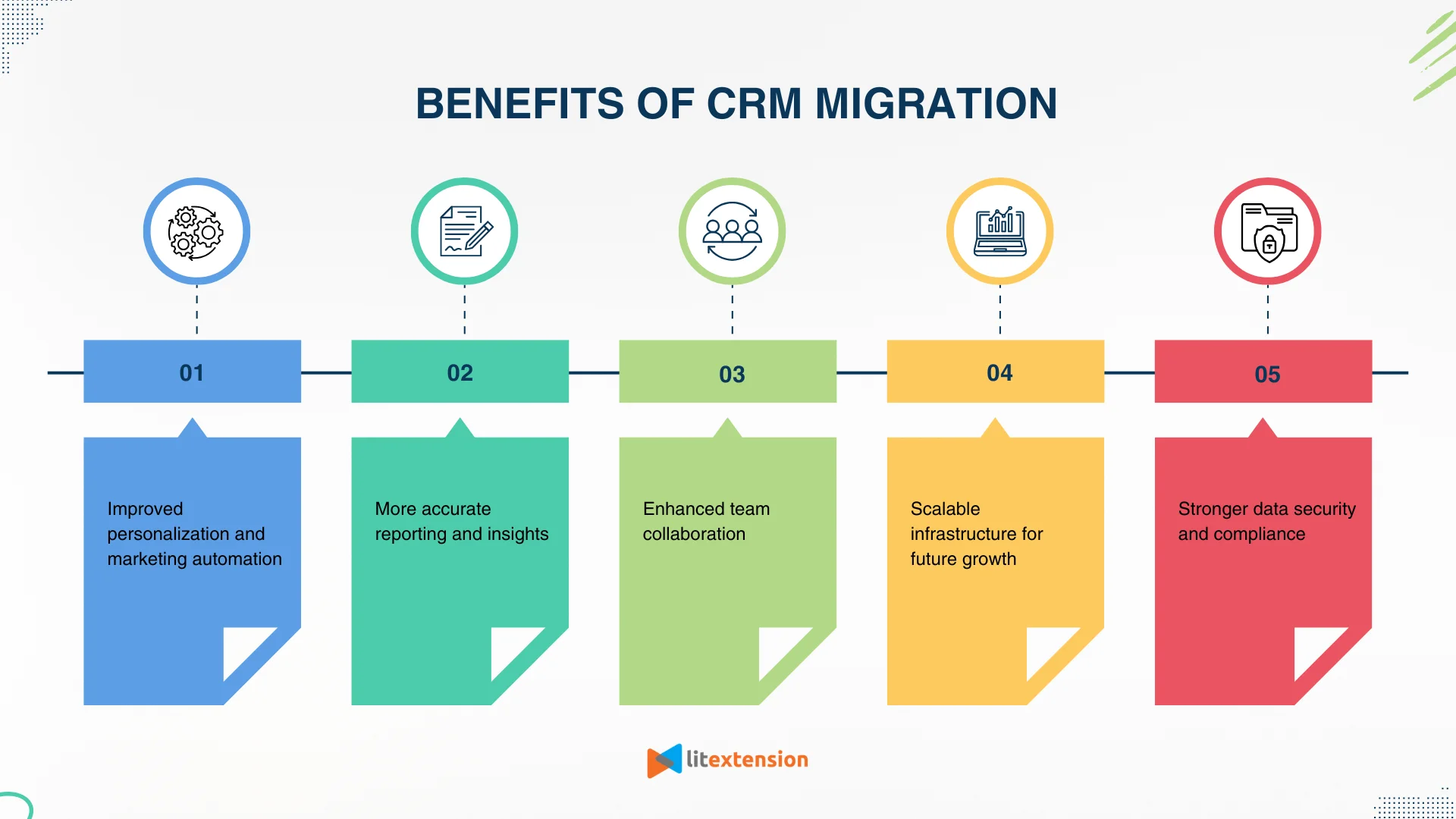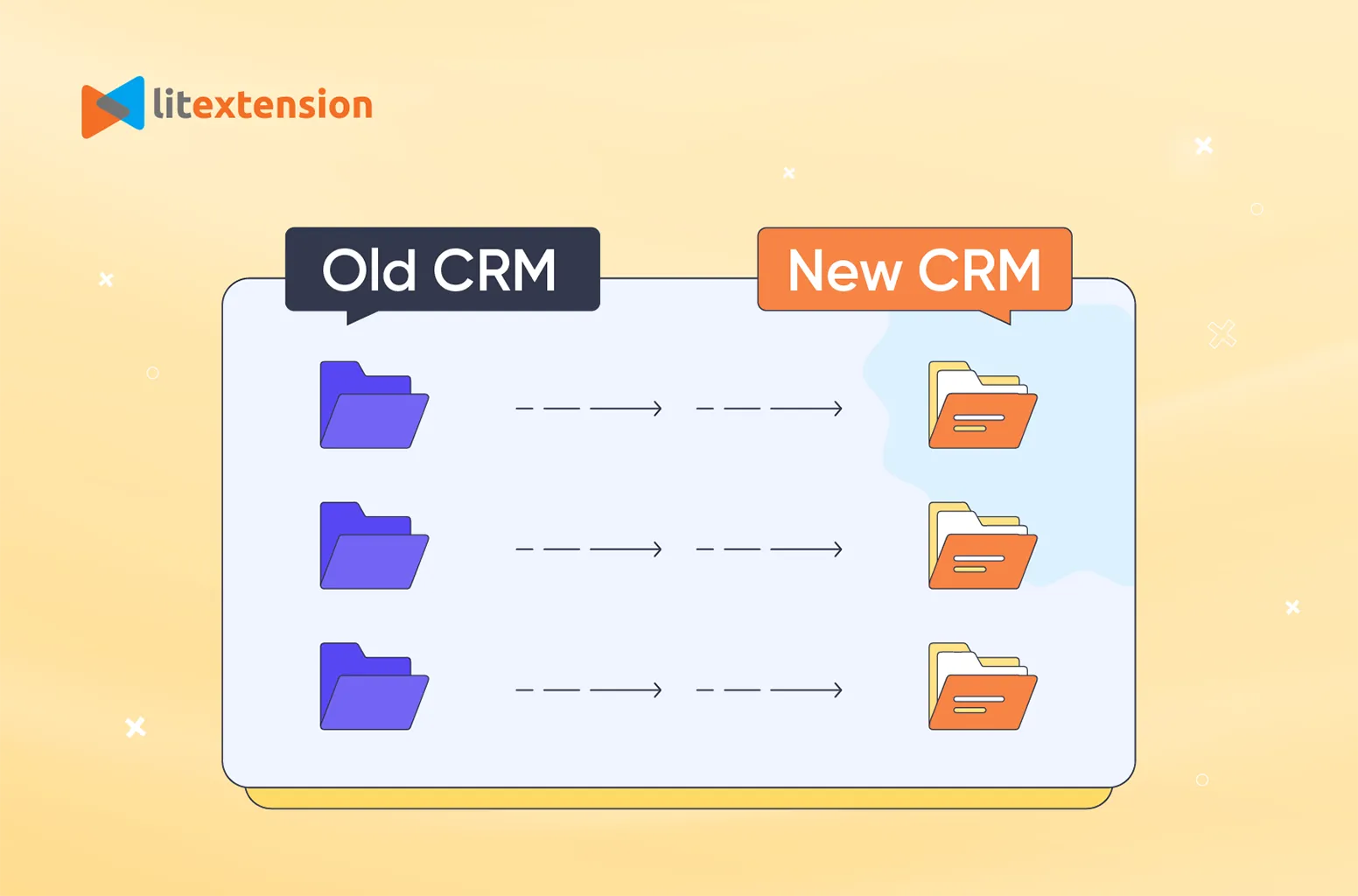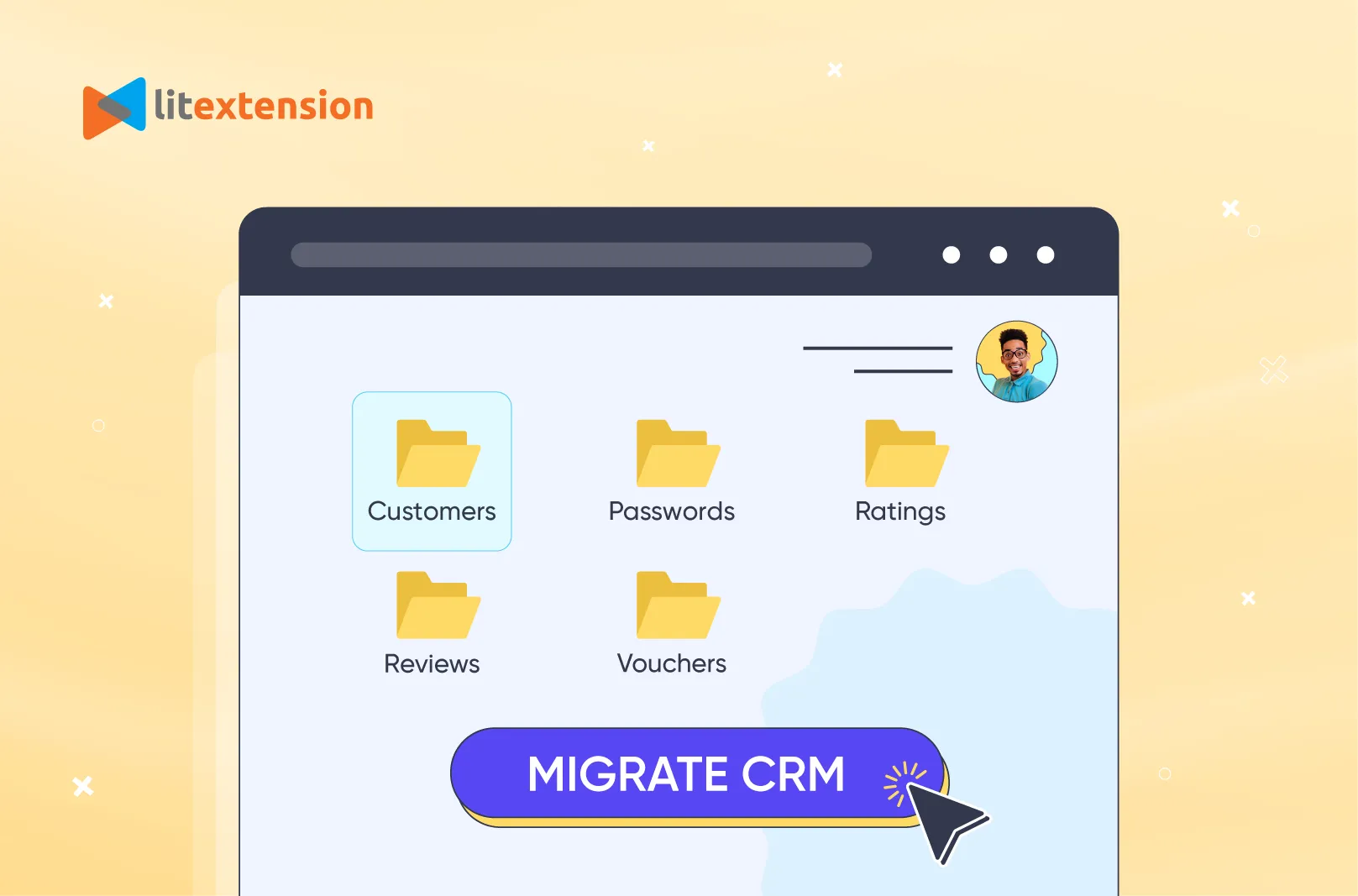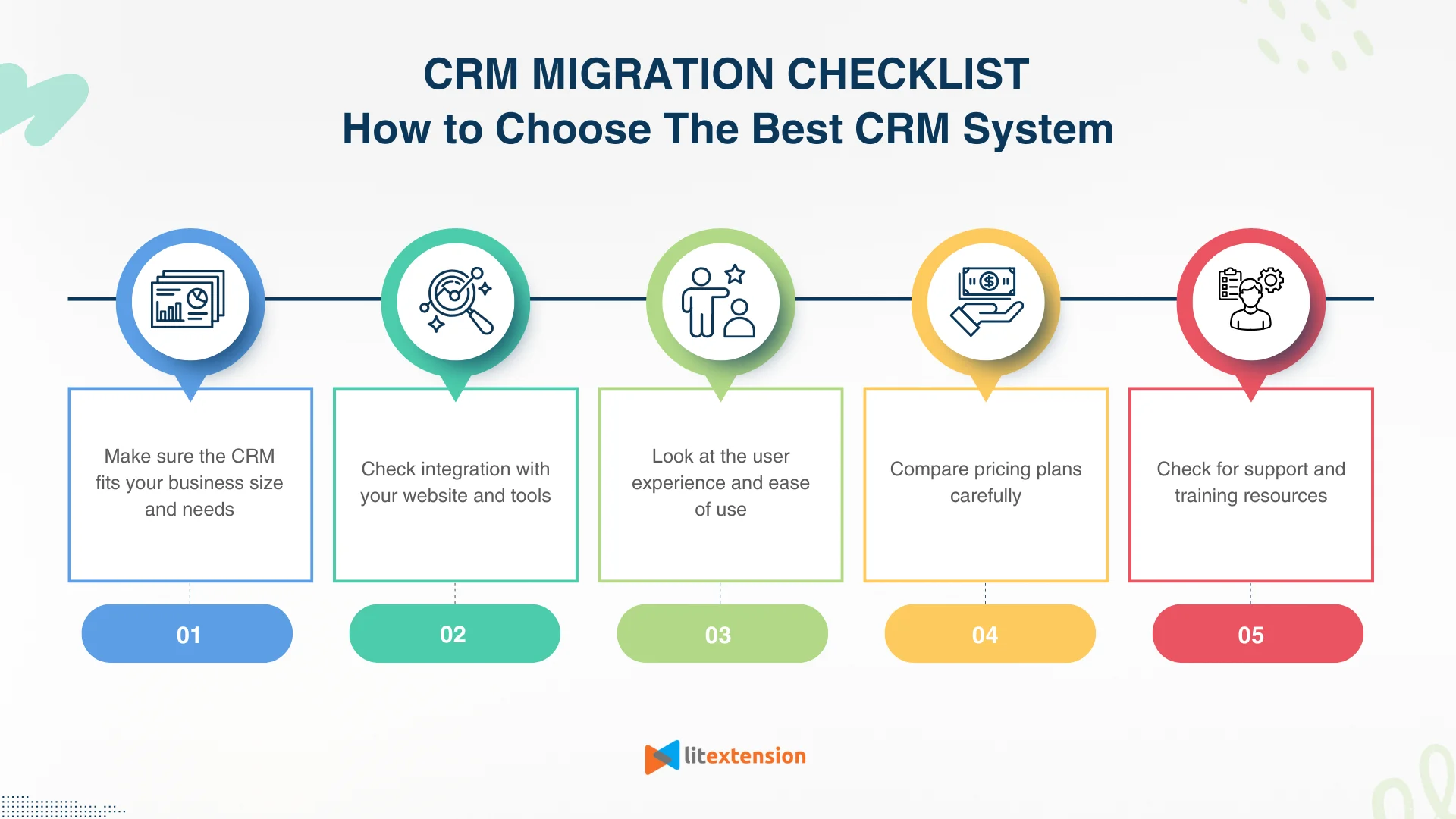Moving from one CRM system to another can feel like a big step, but with the right plan, the process becomes much easier. That’s where a CRM migration checklist comes in, giving you a clear path to follow and helping you avoid common mistakes.
This guide will walk you through a complete CRM migration checklist, breaking down into 8 steps as below:
- Step 1. Get the team ready
- Step 2. Review your CRM
- Step 3. Choose a new CRM
- Step 4. Back up your data
- Step 5. Create a data mapping plan
- Step 6. Run test migration
- Step 7. Migrate to the new CRM software
- Step 8. Monitor the result
Additionally, in this article, LitExtension – #1 eCommerce Migration Service will walk you through the following key points of CRM migration:
- Understanding the definition of data migration CRM
- Benefits of CRM migration to your operation
- Common CRM migration challenges you'll face
- How to choose the best CRM system
- The best method to migrate CRM software
Dive into the details with us now!
What is CRM Data Migration?
CRM data migration involves transferring client data, attachments, and other resources from one CRM platform to another. This process is more intricate than we think because it entails thorough preparation and analysis to ensure no data is lost or altered during the transition. Additionally, it necessitates researching and selecting the most suitable CRM software for your company that fulfills all your requirements.
Despite the complicated process, moving to a new CRM migration brings back many benefits. In short, an efficient CRM data migration greatly boosts business functionality. When executed properly, it reduces a company's IT expenses, enhances productivity, offers greater adaptability and advanced security. Thus, you will be able to strengthen client satisfaction, business retention, and overall data management.
Benefits of CRM Migration to Your Website
Migrating to a new CRM system can do more than just move your customer data. It can also improve how your website works and how your team connects with your customers. With the right CRM migration checklist, your business can gain several important benefits that support both growth and efficiency.

1. Improved personalization and marketing automation
A modern CRM system helps you personalize user experiences based on real-time data. You can set up email campaigns triggered by customer actions on your website or display targeted product recommendations. This level of automation not only saves time but also boosts conversion rates.
2. More accurate reporting and insights
A new CRM often comes with better reporting tools. These tools give you detailed insights into sales, customer engagement, and website performance. When all your data is connected, you can make smarter decisions backed by numbers, not just guesses.
3. Enhanced team collaboration
CRM systems help different teams, like sales, marketing, and support, work from the same data source. This shared access leads to faster responses, fewer mistakes, and a more connected customer journey on your website.
4. Scalable infrastructure for future growth
As your business grows, your CRM should grow with you. Migrating to a more flexible system gives you the freedom to add new features, connect more tools, and handle more customer data without slowing down your website or backend operations.
5. Stronger data security and compliance
New CRM platforms are designed with updated security standards. By running the CRM migration checklist, you reduce the risk of data breaches and ensure that your website complies with privacy regulations like GDPR or CCPA. This builds trust with your customers and protects your brand.
With these benefits in mind, it’s easy to see why following a solid CRM migration checklist is so important. It helps your website run better, your team work faster, and your business grow stronger.
How to Migrate Data for Your CRM Software?
As stated previously, moving CRM data is a complex undertaking that demands a careful data migration project plan. To help you save time and resources, we have compiled a full checklist of steps needed to run your data CRM migration.
Step 1. Get the team ready
For a seamless journey, the CRM migration strategy starts with informing your team. This involves training employees on the new platform, defining clear objectives, and assigning specific roles and responsibilities.
Your staff represents your company's image. It's important to communicate the migration with all those impacted by the change. Our advice is to ensure adequate support resources are available to assist your staff whenever necessary.
Step 2. Review your current CRM
Now that the team has caught up with your plan to move to a new CRM software, it’s time to review your current CRM. This will allow you to pinpoint any existing issues, assess your CRM requirements checklist, and establish expectations for the new software.
With your deep understanding of the old and new CRM software, make sure to create a detailed CRM migration checklist. It should include all the necessary tasks you need to complete as well as important data you should be careful with before making any changes.
Once you've identified the data elements, it's crucial to address the data structures. They are the methodology used to store, organize, monitor, and modify data elements. Ensuring that data structures are migrated to align with the target CRM system is key to ensuring a successful CRM data migration.
Step 3. Choose a new CRM
Every business is distinct with its own set of requirements. With our experience in providing data migration services, choosing a suitable CRM for your business is more crucial than a popular one.
Some factors that should be considered are budget, scalability, and customization capabilities. Above all, the chosen CRM should address the shortcomings identified earlier and help overcome them effectively. For more details, you can refer to the documentation of the new CRM to acquire a comprehensive insight into the entire system.

Step 4. Back up your data
Before getting into the real work of your CRM migration, we can’t skip through backing up your data. Although your CRM data migration might proceed without issues, it's crucial not to overlook this precaution. You wouldn’t want to lose all of your important data just because of underestimation.
It's recommended to securely store this backup in a location such as a cloud storage service or an external hard disk to prevent data compromise. This backup serves as a safeguard in case of any errors during the migration process resulting in data loss.
These are the primary custom fields and groups that you should save a backup for:
- Customer information.
- Documents & files.
- Generated reports.
- Generated exports.
5. Create a data mapping plan
Data mapping plays a crucial role in transferring data from one CRM system to another. Once the data migration strategy is implemented, it's essential to know where your data should be placed.
Each CRM system uses a different default setting and database regulations. Thus, the organization of your old and new CRM will likely not be identical.

For instance, let's consider a data migration scenario involving a customer named Adam. Initially identified through a social media marketing campaign, Adam is categorized under the “Potential customers” group. Upon making a purchase and having a positive customer experience, Adam's data entry transitions to the “Loyal customers” group. Therefore, when migrating to a new CRM platform, it's essential to map Adam's data in a way that reflects his updated status in the appropriate group rather than retaining the older data entry group.
You should begin by documenting all data fields utilized in your current CRM and identifying their corresponding fields in the new system. Then, differentiate between mandatory and optional fields in the new CRM platform to pinpoint any data gaps and prioritize essential information for your organization.
Last but not least, you should develop a plan for managing historical data and address any archiving requirements. A well-defined strategy for historical data management guarantees data integrity and compliance.
6. Run test migration
We all want a guaranteed CRM migration result. For this reason, we highly recommend you take a test migration beforehand. This allows you to familiarize yourself with the process and potential data migration challenges. Any issues encountered during this initial phase can be promptly addressed to prevent complications during the migration of the entire dataset.
7. Migrate to the new platform
After successfully importing a small dataset, you can proceed with importing your entire dataset. Following the completion of the migration, it is recommended to conduct a thorough data validation to verify its accuracy.
Concurrently, it's advisable to commence training your team on the usage of the new CRM. This entails educating them about its features, navigation, and effective utilization.

8. Monitor and test the result
Following the full CRM migration checklist, you can move on to validate the accuracy of the transferred data and tidy up any discrepancies. Your CRM evaluation checklist is recommended to verify random records and associated data, such as the functionality of attachments.
For critical data, consider employing a custom script to validate data integrity between the new CRM system and the previous one. Although time-consuming and costly for large datasets, this approach provides peace of mind. Lastly, review the data for duplicate records, potential mergers, and assess any redundant data that can be discarded.
What Are the Challenges for CRM Migration?
Data migration is no walk in the park. Depending on its scale, this process can become intricate, presenting various challenges along the way. That’s why including a solid CRM migration checklist in your planning stage is essential. It helps you stay organized and prepare for the common problems that may arise during the process.

1. Data incompatibility
Data incompatibility is a frequent issue in CRM migration, particularly when the old and new systems store data differently. For instance, data fields in the old CRM may not match up directly with fields in the new system, leading to misalignment, data loss, or errors during the transfer process.
To overcome data incompatibility, businesses should include careful data mapping in their CRM migration checklist. This process involves identifying how fields from the current CRM align with fields in the new CRM. Some migration tools are designed to handle these complexities by converting data into formats compatible with the new system. Partnering with an experienced migration service can also help avoid compatibility issues, ensuring all data is transferred accurately.
2. Database size
Large databases can significantly slow down the migration process. The more customer records, interaction histories, and data points you have, the longer it will take to complete the migration. This can increase downtime and extend the overall timeline for moving to the new CRM.
To handle large databases, businesses can break the migration into phases. Migrating data in smaller batches reduces the risk of overwhelming the system and helps manage time more efficiently. Additionally, performing a data audit beforehand can help identify outdated or irrelevant information that can be removed, reducing the size of the database before migration starts. This is an important step that you should not ignore in the CRM migration checklist.
3. Website downtime
Website downtime is a critical concern during CRM migration, especially for eCommerce businesses that rely on constant uptime for sales and customer interactions. If not properly managed, migration can result in unexpected outages, leading to lost sales and frustrated customers.
To minimize downtime, businesses should plan the migration during off-peak hours or schedule maintenance windows when fewer customers are active. Another approach is to run the migration in parallel, keeping both the old and new CRM systems active until the migration is complete and tested. This way, if any issues arise, the old system remains functional as a backup. Additionally, make sure that your IT team or migration partner has a clear plan in place to address any potential disruptions swiftly.
4. Financial resource constraint
CRM migration can be resource-intensive, both in terms of time and finances. Small to medium-sized businesses, in particular, may struggle with budgeting for the migration process, as unexpected costs can arise during the transition. These may include paying for additional support services, handling technical difficulties, or extending the project timeline.
To overcome financial constraints, businesses should start by creating a detailed migration budget that includes potential hidden costs, such as additional software licenses, training, and post-migration support. Prioritize features and tasks to ensure the most critical aspects of the migration are completed first. If the budget is tight, consider using automated migration tools, which are often more affordable than hiring external services. Lastly, consult with migration experts to get a clear understanding of the cost involved and to help avoid unexpected financial surprises.
CRM Migration Checklist – How to Choose the Best CRM System
Choosing the right CRM is one of the most important steps in your CRM migration checklist. The system you select will impact how your team works, how your website runs, and how your business grows. To make the right choice, you need to consider a few key points that match your goals and current setup.
1. Make sure the CRM fits your business size and needs
Every business is different: Some CRMs are built for small teams, while others support large companies with complex workflows. You should check if the CRM offers the features you need, such as lead tracking, automation, or support tools, without making things too complicated.
2. Check integration with your website and tools
A good CRM should work well with your existing systems. Make sure it connects easily with your website platform, email marketing tools, and other software you use. This makes your work smoother and helps avoid future technical problems.
3. Look at the user experience and ease of use
Your team will use the CRM every day, so it should be easy to learn and simple to use. A clean interface, fast performance, and clear setup steps will help your team adopt the new system quickly and use it with confidence.
4. Compare pricing plans carefully
CRM pricing can vary a lot. Some tools charge per user, while others offer flat rates or bundles. Make sure you understand the total cost, including setup, extra features, or future upgrades, before you commit. Look for plans that match your budget and still give you room to grow.
5. Check for support and training resources
A strong support team makes the transition easier. Choose a CRM that offers training guides, onboarding help, and reliable customer service. Whether it’s through live chat, email, or a help center, support should be easy to reach when you need it.
By following this CRM migration checklist, you’ll be able to pick a system that fits your business today and supports your growth tomorrow. Taking the time to choose the best CRM will make your migration smoother and your daily operations more efficient.
Best Methods for Data CRM Migration
In this section of the CRM migration checklist, we will walk you through the most common options, so you can decide which method fits your needs.
1. Manual method
Manual migration involves the labor-intensive process of transferring CRM data manually from one system to another. This method typically requires exporting data from the existing CRM, formatting it as necessary, and importing it into the new CRM platform.
While manual migration may seem straightforward, it can be time-consuming and error-prone, especially for large datasets or complex data structures. Additionally, manual migration carries a higher risk of data loss or inconsistencies due to human error.
Despite these challenges, manual migration can be cost-effective for organizations with relatively small datasets and straightforward CRM configurations.
2. Hire an expert
For organizations with complex CRM requirements or limited in-house expertise, hiring an expert or consulting with a CRM migration specialist can be a strategic move. CRM migration experts possess the knowledge and experience to assess the organization's needs, plan the migration strategy, execute the migration with minimal disruption, and provide post-migration support and optimization.
By leveraging the expertise of professionals, businesses can ensure a smoother migration process, mitigate risks, and maximize the benefits of their new CRM system. While hiring an expert may incur additional costs, the investment can pay off in terms of time saved, reduced errors, and improved outcomes.
3. Utilize migration services
Normally, migration service providers specialize in transferring data for both CRM and eCommerce platforms. These services offer a structured approach to CRM migration, providing guidance, tools, and support throughout the process. In addition to data transfer, eCommerce migration services may offer features such as data mapping, customizations, and post-migration assistance.
By leveraging eCommerce migration services, businesses can streamline the migration process, minimize downtime, and ensure data integrity. However, it's essential to carefully evaluate service providers to ensure compatibility with the organization's CRM systems, data security measures, and support capabilities.
Store Migration Made Easy With LitExtension!
LitExtension offers great migration solutions that help you transfer your data from the current eCommerce platform to a new one accurately, painlessly with utmost security.

CRM Migration Checklist – FAQs
What is CRM transfer?
CRM transfer, also known as CRM migration, is the process of moving customer data, contacts, and interactions from one CRM system to another. Businesses often perform this when upgrading to a more advanced CRM or switching systems to better meet their operational needs. It ensures that all customer information and history are preserved during the transition to the new platform.
How to move data from one CRM to another?
To move data from one CRM to another, follow these steps:
- Step 1: Get the team ready
- Step 2: Review your CRM
- Step 3: Choose a new CRM
- Step 4: Back up your data
- Step 5: Create a data mapping plan
- Step 6: Run test migration
- Step 7: Migrate to the new CRM solution
- Step 8: Monitor the result
What are the risks of CRM migration?
The risks of CRM migration include data loss, data corruption, or incomplete data transfer, which could disrupt business operations. Other risks involve system downtime, compatibility issues between the old and new CRMs, and potential costs due to technical complexity or extended timelines. These risks can be mitigated by thorough planning, data backups, and working with experienced migration professionals.
What does CRM stand for?
CRM stands for Customer Relationship Management. It refers to the technology and processes used by businesses to manage and analyze customer interactions and data throughout the customer lifecycle. A CRM system helps companies improve customer service, enhance sales processes, and strengthen relationships by organizing and automating communications, sales tracking, and support services.
Key Takeaways
In conclusion, a well-planned and methodically executed CRM migration checklist helps businesses maximize the benefits of their new platform while minimizing risks. Following the steps outlined today enables organizations to efficiently transfer all critical customer, financial, and operational data with integrity.
If you are struggling with your CRM migration, LitExtension is welcome to help. Send us a request, and we will happily support you to the best of our ability. Besides, we also specialize in migrating between 140+ eCommerce platforms, including Shopify, WooCommerce, BigCommerce, etc.
If you like this article, don't forget to check out other blogs about eCommerce migration on our website to get more insights.


